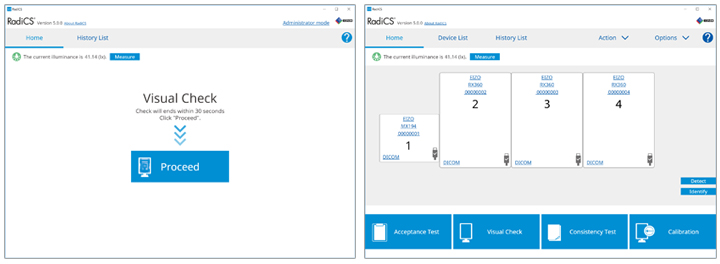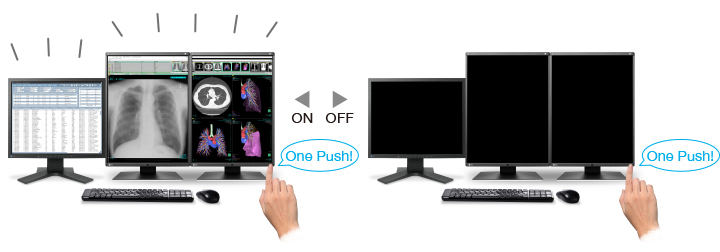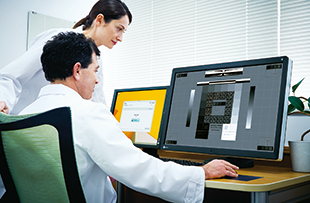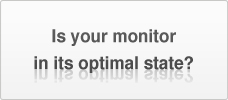RadiCS UX2 Quality Control & Calibration - RadiForce | EIZO
RadiCS UX2Quality Control & Calibration
- Features
- Specifications
- Documents Compatibility
- Graphics Boards
- QC Software & Tools Accessories
Optimal Quality Control of Monitors in Your Hospital
Maintain Quality Control of Individual Monitors
Ensuring that the quality control of each client monitor complies with important medical standards, from calibration to acceptance and constancy tests to history and asset management, requires technical know-how and experience. EIZO offers software and sensors that makes quality control efficient and user-friendly.

Improved User-Interface and Enhanced Operability
Graphical design and icons are arranged next to the text making it easy to comprehend the functions visually and intuitively. A compendium list also enables users to check the condition of monitors instantaneously. Furthermore with the intuitive on-screen wizard, you can easily complete monitor inspection and calibration.

Acceptance and Constancy Testing in Easy Steps
RadiCS enables you to perform brightness, grayscale and uniformity checks that comply with AAPM TG18, DIN 6868-157, and other QC standards.
DICOM Part 14 Calibration
The built-in backlight sensor enables simplified calibration compliant with the DICOM Part 14 standard to correct the grayscale tones and brightness of the monitor. Furthermore, the use of an Integrated Front Sensor (IFS) or bundled UX2 Sensor enables higher calibration performance.

Flexible Schedule Setting
The timing of when to perform QC tasks such as daily tests or constancy tests can be set according to the needs of your institute. For example, when turning the PC on or just after a specific application is opened.

Work on a Virtual Desktop Infrastructure (VDI)
For the purpose of improving work efficiency, reducing costs, and saving space, virtual desktops are becoming increasingly common in the healthcare field. With RadiCS Version 5.0.0, all functions are accessible on client monitors from a virtual desktop infrastructure.
* It is necessary to install RadiNET Pro Server in order to save settings and history of individual monitors.

Improve the Interpretation Workflow
To improve work efficiency, EIZO's unique Work-and-Flow provides various functions for providing a comfortable reading environment. These include functions such as the Auto Brightness Switch which dims the brightness of patient lists when not in use, for improved concentration during interpretation.
* Function availability varies by monitor model.

Improved Concentration
When interpreting images, the bright screen of a patient list on an external monitor can be distracting. With the Auto Brightness Switch function, the brightness of a connected FlexScan EV-Series monitor automatically dims when the cursor is moved out of the screen. This makes it easier to concentrate on diagnostic images and also saves on power consumption.

Save Power with Ease
With the Monitor Power Switch function, all monitors can be turned on or off just by touching one monitor. When leaving your desk, switching off all monitors is quick and easy.
* This feature is limited to EIZO monitors connected via USB.

Other Features:
- Historical Management and Report Generator
- Continuous Asset Management
- Backlight Meter
- Distinct QC for All Modes
- Low-Power-Consumption with Backlight Saver
- Compatible with Non-RadiForce Monitors
"Assessment of Display Performance for Medical Imaging Systems" formulated by Task Group (TG) 18 of American Association of Physicists in Medicine.
  ACR-AAPM-SIIM "Practice Guideline for Determinants of Image Quality in Digital Mammography" ACR-AAPM-SIIM "Practice Guideline for Determinants of Image Quality in Digital Mammography"
  NYC Quality Assurance Guidelines for Primary Diagnostic Monitors NYC Quality Assurance Guidelines for Primary Diagnostic Monitors
"Recommended Standards for the Routine Performance Testing of Diagnostic X-ray Imaging Systems" formulated by the Institute of Physics and Engineering in Medicine in the UK.
"Image Quality Assurance in X-ray Diagnosis - Part 57: Acceptance testing for image display devices" formulated by the German Institute for Standardization (Deutsches Institut für Normung e.V).
"Guideline for implementing quality assurance of the X-ray systems for diagnostic and medical treatment purposes according to the chapter 16 and 17 of the X-ray Ordinance". This defines the details of the quality assurance of general X-ray systems obliged by the X-ray Ordinance.
|
| Compatible Operating Systems |
Windows 10
Windows 8.1 Windows 7 / Windows 7 SP1 |
|---|---|
| Display Functions | DICOM Part 14 GSDF, CIE, Exponential (gamma value), Log Linear, Linear, User definition |
| Interface | USB, RS-232C |
| Languages | English, German, Japanese, Chinese, French |
| Package Contents | RadiCS DVD-ROM (RadiCS, User's Manual), UX2 Sensor, Adsorptive sheet for the replacement, cleaning cloth, UX2 Sensor Instructions for Use |
- Quality Control External Calibration Sensor
- New user-friendly design

- Software for major version up of RadiCS

- License to use RadiCS with other commercially available monitors

Contact EIZO
EIZO Inc.
Address:
5710 Warland Drive, Cypress, California 90630
Telephone:
(+1) 562 431 5011






 EUREF "European Guidelines for Quality Assurance in Breast Cancer Screening and Diagnosis Fourth Edition"
EUREF "European Guidelines for Quality Assurance in Breast Cancer Screening and Diagnosis Fourth Edition"
 IPEM Report 91
IPEM Report 91
 DIN 6868-157
DIN 6868-157

 ONR 195240-20: 2017
ONR 195240-20: 2017  JESRA X-0093*B-2017
JESRA X-0093*B-2017 "Quality Assurance (QA) Guideline for Medical Imaging Display Systems" formulated by Japan Industries Association of Radiological Systems (JIRA).
"Quality Assurance (QA) Guideline for Medical Imaging Display Systems" formulated by Japan Industries Association of Radiological Systems (JIRA).











